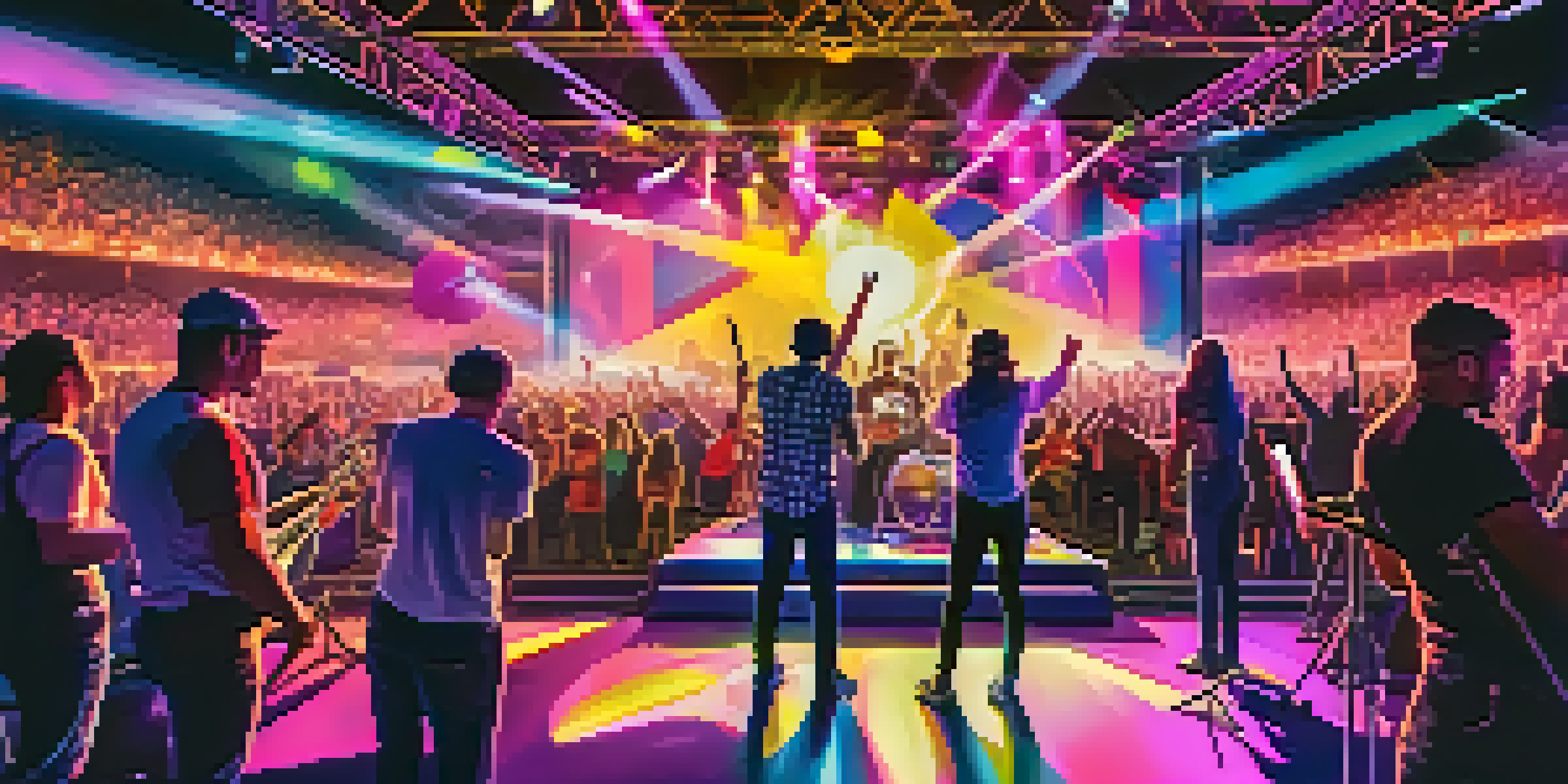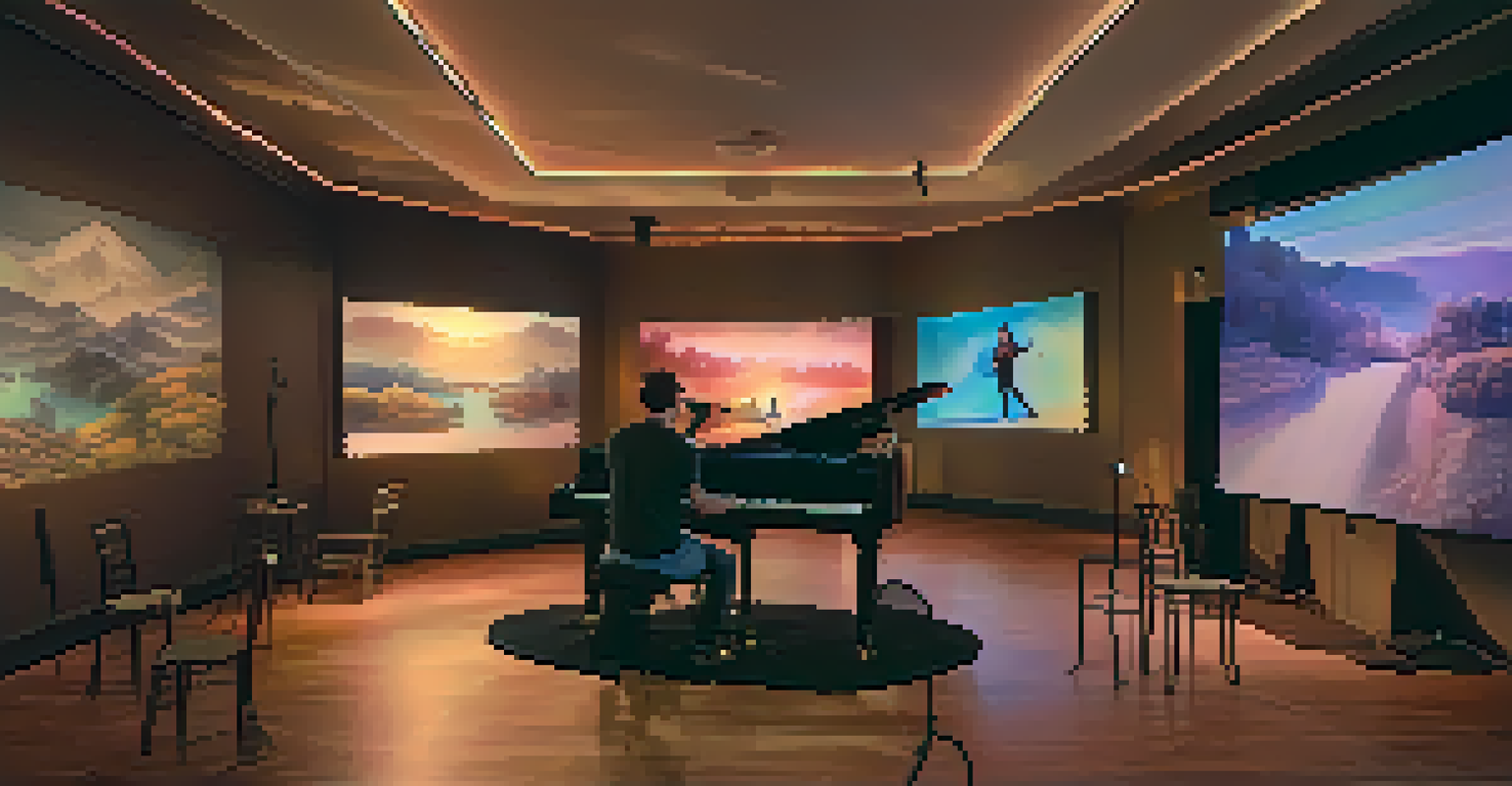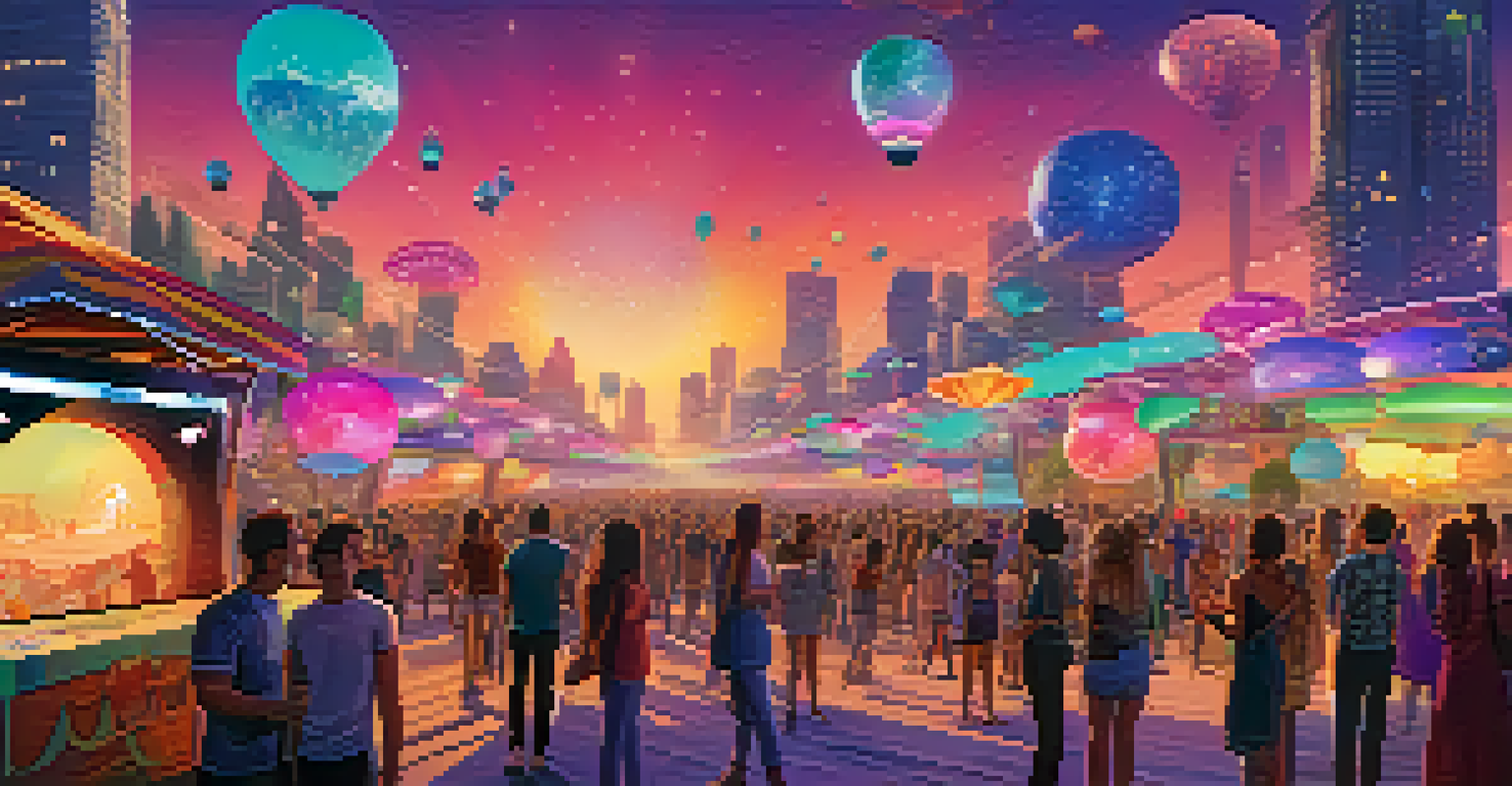The Impact of Augmented Reality on Live Concerts

Understanding Augmented Reality and Its Basics
Augmented Reality (AR) merges the physical and digital worlds, enhancing our real-life experiences with virtual elements. Imagine watching your favorite band play live, but with vibrant 3D visuals dancing around them, making the event feel even more immersive. This technology uses devices, like smartphones and AR glasses, to superimpose digital information onto the real world, creating a unique blend of entertainment.
Augmented reality is not just a technology; it’s a new way of experiencing the world around us.
For concert-goers, AR adds layers of interaction that weren't possible before. Fans can see animated visuals that react to the music or even interact with the band in real time. It’s like adding a sprinkle of magic to an already thrilling experience, allowing attendees to engage with the performance on a whole new level.
As AR technology continues to evolve, it’s essential to understand how it can be integrated into live events. This innovation not only enhances the audience experience but also opens up new avenues for artists to communicate their message, making concerts more memorable and engaging.
Enhancing Audience Engagement Through AR
One of the standout features of AR is its ability to boost audience engagement during concerts. Picture this: as the band plays, fans can use their smartphones to unlock interactive content, such as behind-the-scenes footage or exclusive interviews with the artists. This not only keeps the audience entertained but also creates a deeper connection with the performers.

Incorporating AR elements into live shows allows fans to participate actively rather than just passively watching. For instance, some concerts have included AR animations that fans can summon during specific songs, creating a collective experience that unites everyone in attendance. This sense of community enhances the overall atmosphere, making it more than just a concert.
AR Enhances Concert Engagement
Augmented Reality transforms live concerts by allowing fans to interact with digital content, deepening their connection to the performance.
Moreover, the thrill of engaging with AR can lead to social media sharing, as attendees capture and share their unique experiences with friends. This boosts the concert's visibility and helps artists reach a wider audience, proving that AR can significantly impact not just the event itself but also its aftermath.
AR's Role in Creating Unique Visual Experiences
Visuals play a crucial role in concerts, and AR takes this to a whole new level. Imagine a stage where the visuals are not just limited to lights and screens but extend into the audience’s field of vision. This creates an unforgettable spectacle that captivates the eye and enhances the overall performance.
The future of live music is about creating experiences that engage the audience on multiple levels.
By integrating AR, artists can create a narrative that complements their music. For example, during a song about a journey, AR could visualize landscapes or scenes that change with the rhythm, immersing the audience in a story. This level of creativity can elevate a standard concert into an extraordinary event that resonates long after the last note.
Additionally, AR allows for personalized experiences. Fans can tailor their AR interactions, choosing what visuals they want to see based on their preferences, making each concert feel unique. This personalization fosters a deeper emotional connection to the performance, as each attendee engages with the music in their own way.
Building a New Revenue Stream with AR Events
The integration of AR in live concerts not only enhances the experience but can also create new revenue opportunities for artists and venues. By offering exclusive AR content, such as special effects or virtual meet-and-greets, promoters can charge a premium for enhanced ticket packages. This can significantly boost overall profits while providing fans with something truly special.
Moreover, virtual concerts that utilize AR technology can reach a global audience, breaking down geographical barriers. Imagine a fan in another country experiencing the same concert as those in attendance, complete with interactive AR elements. This opens up new markets and increases the potential fan base for artists, creating additional revenue streams through merchandise and digital content sales.
New Revenue Streams with AR
Integrating AR in live events creates opportunities for artists to offer exclusive content, leading to increased profits and a broader audience reach.
As artists and promoters recognize the financial benefits of AR, we can expect to see more innovative applications in the concert scene. This shift can lead to a more sustainable model for live music events, allowing artists to thrive while continuing to entertain their fans creatively.
Challenges of Integrating AR in Live Concerts
While the benefits of AR in concerts are exciting, there are challenges that come with this technology. One significant hurdle is the need for high-quality infrastructure to support AR experiences. Venues must invest in advanced technology, such as high-speed internet and powerful projection systems, to ensure that AR elements run smoothly without glitches that could disrupt the performance.
Another challenge is the learning curve for both artists and audiences. Not everyone is familiar with how AR works, and some fans may struggle to interact with the technology during a live event. This can create frustration and distract from the overall experience, highlighting the importance of providing clear instructions and support for attendees.
Lastly, the cost of implementing AR can be a barrier for smaller venues and independent artists. While larger events can absorb these costs, smaller shows might struggle to justify the investment. This disparity could lead to a divide in the concert experience, where only big-name acts can afford to offer these enhanced features.
The Future of AR in Live Music Events
Looking ahead, the future of AR in live music events appears bright. As technology advances and becomes more accessible, we can expect to see a growing number of concerts incorporating AR elements. This could lead to more creative performances that push the boundaries of traditional music shows, offering fans exciting new experiences.
Additionally, as more artists embrace AR, fans will likely develop higher expectations for live events. This trend will encourage artists to innovate and experiment with their performances, potentially leading to a renaissance in live music where every concert is a unique production. The challenge will be to strike the right balance between technology and the authentic connection that live music provides.
Challenges of AR Implementation
Despite its benefits, integrating AR in concerts poses challenges, including the need for advanced technology and the cost barriers for smaller venues.
Ultimately, the evolution of AR in live concerts represents a significant shift in the music industry. With its ability to enhance engagement, creativity, and revenue, AR is poised to redefine how we experience live performances, making each show a thrilling adventure that resonates with fans long after the music fades.
Conclusion: Embracing AR for a New Concert Experience
In conclusion, augmented reality holds immense potential for transforming live concerts into immersive experiences. By enhancing audience engagement, creating unique visuals, and opening new revenue streams, AR can elevate the concert experience to new heights. However, it’s essential to address the challenges that come with this technology to ensure that all fans can enjoy the benefits it offers.
As artists and promoters continue to explore the possibilities of AR, we can anticipate a future where live music is not just about the sound but also about the entire experience. The integration of AR could lead to concerts that are not only visually stunning but also deeply engaging, fostering connections between artists and fans.

By embracing augmented reality, we are not just enhancing the concert experience; we are shaping the future of live music. As we move forward, it will be exciting to see how artists incorporate this technology and how it evolves to create unforgettable moments for concert-goers around the world.